
|   |

|   |
 e-mail: sunilkothari1933@gmail.com Adhyasha Foundation's Shishirchhanda Festival Photos: Srivatsa Shandilya December 27, 2019 Sarita Mishra, disciple of Yudhisthir Nayak and Bichitrananda Swain, moved in 2013 to Bangaluru. She established Adhyasha Foundation to teach Odissi with a cross section of disciples from diverse fields - banking, designing, professional interior designers, from IT, housewives, dancers from different dance styles and also foreigners. Within a short time, there was rapid growth of the foundation with the result that Sarita set up few branches. Within a short time, she has won appreciation from local established senior dancers and gurus and her two day annual festival is eagerly awaited. 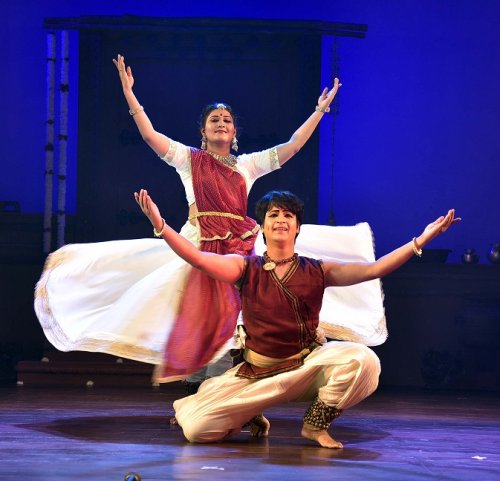 Laxminarayan Jena and T Prarthana This year, the venue was Seva Sadan for 14th and 15th December. On the opening evening, the participants were young dancers Laxminarayan Jena and Dr. Prarthana T, disciples of Mysore Nagaraj. The prayer Omkarini based on Balamuralikrishna's composition saw them in devotional mood. Laxminarayan Jena has a well built, rather athletic body, and he performs with confidence, good sense of tala and laya and impresses the onlooker with his neat movements. His counterpart Prarthana's movements were graceful becoming a nayika. As Tripurasundari, she assumed the role of the fierce goddess who annihilated the demon Mahishasura. The iconic figure was well enacted. For abhinaya, the sequence was one similar to khandita nayika. Radha awaits Krishna in bower but he does not arrive at appointed time. She is unhappy and when Krishna comes, she rejects his advances. He asks her to forgive him and falls at her feet. Their guru had selected Dr. Shatavadhani Ganesh's Sanskrit composition Radha Bhava Madhava that dwelt upon Radha wanting Krishna to realize that their love is not merely physical but elevating and spiritual. Krishna will only know it when he would become Radha. After the usual dallying, Radha begs of Krishna to become Radha and leaves him. Krishna dons female garments to turn into Radha to experience Radha's emotions and love for him. He crosses the forest, overcomes the obstacles of a serpent, rain, lightning and understands that as vasakasajja, khandita, abhisaraika, virahotkanthita, anxious to meet Krishna how Radha goes through various stages. It was an interesting composition. Both Laxminarayan Jena and Prarthana did justice to the composition and its inner meaning. 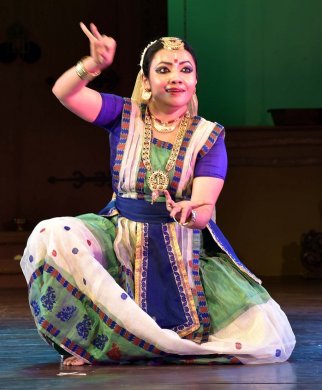 Anwesa Mahanta In 2000, Sattriya dance of Assam has been recognized as eighth classical dance form in various metropolitan cities, but Sattriya dance style is not as known as Odissi or Kuchipudi. Dr Anwesa Mahanta, disciple of Guru Ghanakanta Bora, has been trained from very young age into this dance style and is well known for her nritta and abhinaya. She selected two numbers from her repertoire. The first one was taken from Keli Gopal, Ankia Nat, and illustrates the realization of Jivatma and Paramatma. The entire creation of Gopa, Gopikas is part of Supreme Being. The qualities of Purusha and Prakriti are in every being. The nirvana moksha is achieved by reciting Nama. Set to raga Shyam and Gauri in series of tala, it was performed by Anwesa with deep feeling. However it was also in nature of abstraction and at times difficult to comprehend unless one has the background of the philosophy it propounds. Anwesa was in her element in Nrusimha Lila which is based on the story of Hiranyakashipu and his son Prahlada, devotee of Vishnu. The story is well known and went well with the audience. Hiranyakashipu sends his minister to punish Prahlada, but each time he is saved. Hiranyakashipu questions him if his lord is in a pillar which he strikes and out comes Nrusimha who kills Hiranyakashipu and invites Prahlada to sit on his lap. While enacting two roles, Anwesa invested her abhinaya with necessary ferocity of the demon king and often screamed in anger, enhancing the dramatic quality of the piece. Alternating with pure dances, landing softly and not stamping the stage strongly, what in Sattriya is known as Ula, she contrasted it with her heroic abhinaya which suited the role of the demon king. As Prahlada, she recited the name of the lord gently and quietly. Thus in ekaharya lasyanga abhinaya, wearing the same costume, she succeeded in projecting two characters distinctly. Normally, Sattriya is with Gayan Bayan, drum dance, seen as a group dance. But it has also developed solo presentation drawing inspiration from the Ankiya Nat, dance drama form of Sattriya. 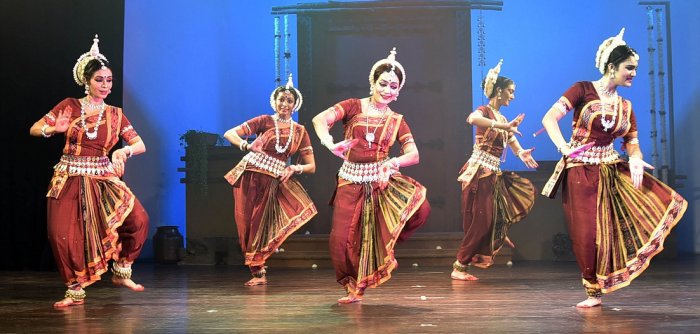 Sarita Mishra and her ensemble The main performance of Odissi by Sarita Mishra and her troupe followed with opening number of Kannada song Sharashringarpuradishwari Sharade, in praise of deity of Shringarpura. Written by Parma Charan Shringeri, it tells story of how the goddess Saraswati stopped in her tracks when promising Shankaracharya that she will follow him, but with a condition that he must not look back. At one point when Shankaracharya could not listen to the ankle bells of the goddess, he looked back to see if she was following him or not. The goddess then stayed back at that spot in the hills of Western ghats. Sarita enacting the role of Shankaracharya, full of devotion, and Radhika Makaram that of goddess Saraswati, brought alive the iconic beauty of the goddess, how the goddess embodies all arts, seven swaras, associated with gods like Surya, Narayana, Ganapati, Shiva, Parvati, Shanmukha and Narada; also with the melodious music of instruments like sitar, manjira, mardala, violin. Her blessings are seen in our daily mundane lives like plucking flowers, making garland, rowing boat, drawing rangoli, fishing and even sculpting; in the flight of the birds, jumping of the deer, grace of elephant, serpentine movement and so on. It also embodies poetry and literature. The music was composed by Srinibas Satpathy, the rhythm by Bijay Kumar Barik and choreography was by Sarita Mishra. The Kannada song was adopted by Radhika in Odissi. The inputs were by Vivek Sridhar. It was a welcome attempt to have Kannada song in Odissi repertoire suggesting meeting of two cultures. The evergreen Basant Pallavi choreographed by Guru Kelucharan Mohapatra with a beautiful dhyana shloka in Basant raga and eka tali, in its lyrical movement continues to delight the audiences. The dancers with uniform training in group displayed attractive visuals. The young dancers including tiny tots showcased a number called Jalabindu, an excerpt from 'Varsha Varnali' choreographed by Aruna Mohanty, rearranged by Sarita. It was interesting to see the coordination between junior and senior dancers. The droplets of rain falling, the lightning and the mood of rain were well projected. 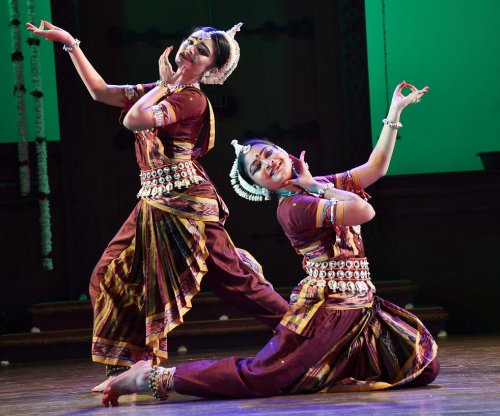 Srishti Ratha & Mugdha Samant The abhinaya to Banamali's Odiya composition Mohana murati chailo choreographed by Bichitrananda Swain was performed by the twelve year old dimpled beauty Srishti Ratha (Rhea), daughter of Sarita. She and another young dancer Mugdha Samant, became the two young nayikas, gopis who were enchanted by seeing the handsome Krishna. The moment they heard his sweet flute, their hearts melted. Describing his beauty, one sakhi says that even bright sapphire would pale in comparison. The swift eyes of a deer do not attract as the lotus shaped eyes of Krishna. One of the similes the poet employs is very attractive. As fishing net catches the fish, so are the women of Vrindavan caught in the net of his flirting eyes! Leave alone that, his speech is elixir, pure nectar. It seems Lord Brahma created him as the divine man to fulfill the desire of all women. Could he be Rama or Shiva? No. If he were Rama, then Sita would have accompanied him. And if he were Shiva, Parvati would have accompanied him. He is none other than our beloved Krishna who is more handsome than Madana.The sakhi enamoured by the beauty of Krishna lingers long looking in the direction Krishna is playing flute. The other sakhi asks her to move on, but the magic of Krishna continues to lure her. The music was composed by Dr. Sangita Gosain, and was set to raga Bhairav. Both the young dancers projected the mesmerizing impact nicely with innocence, captivating the beauty of the poem. Shivapanchaka, a prayer to Lord Shiva choreographed by Guru Gangadhar Pradhan with a shloka describing him in his Ardhanarishwara form and his divine beauty, in exquisite Sanskrit poetry was performed by a group of senior dancers. Churna kuntal netra ujjvala, the earrings and the eyes that shine, hasta nirmal. Danda trishula, hand holding trident, and on forehead adorned by Kaustubha, such lord, O Shivapati, Parvati Pati, save me - Trahi maam. The devotee prays to the lord who is Panchanana, with five faces. It was enriched by rhythmic syllables and created the iconic form of Shiva. The devotee begs of the lord to release him from the ocean of worldly bondage. The nritta portion was lively. The finale Moksha Mangalam, choreographed by Sarita Mishra, with music by Srinibas Satpathy, rhythm by Bijay Kumar Barik highlighted the elements which sustain the earth. It was a celebration of dance and seasons.The Sanskrit text speaks of Purusha Mangalam and describes the formation of Purusha.The five elements of fire, water, earth, ether, and wind were invoked. The Odissi recital by Adhyasha ensemble concluded with this enchanting auspicious prayer spreading peace in world. 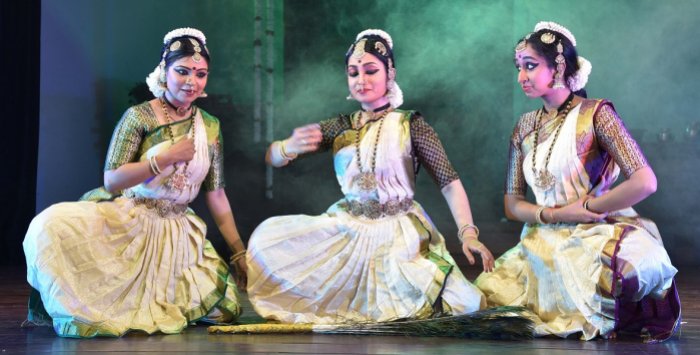 Rasika ensemble The Rasika ensemble of Kiran Subramanyam and Sandhya Kiran, presented two numbers in Bharatanatyam, full of punch, sparkling and lively. Their training is thorough and they have created their own niche. Their young disciples are a legion. They presented a prayer on Lord Shiva, presiding deity of Chamtakarapura. Composed by Muthuswami Dikshitar in raga Bhoopalam and tala adi, choreographed by Kiran Subramanyam, it was performed competently by three young dancers Rasika Kiran, Shivaranjani Harish and Pavithra Krishnamurthy. The item stood out for their clear nritta, perfect adherence to tala and rhythm, a special feature of Rasika ensemble. It displayed geometry and rhythm and aesthetically brought out the abstract aspect of the lyrics. The similes for Lord Shiva as a wish fulfilling tree, Kalpa Vriksha, remover of all sorrows, refuge to who seek his shelter and as Sadashiva who bestows his blessing on his devotees. The padam in Tamil, Kanda naal mudalai featuring Rasika, Shivaranjani and Archana HR stood out for the subtle humour. The poet says: 'Don't we all know that Subramanya was one of the most handsome of the gods? His intelligence and looks were both unmatched and so many young damsels fell in love with him.' The poet further says: 'Here is a situation typical of this. Two nayikas speak to their sakhi about their romantic feelings for Muruga, both of them unaware that they are in love with the same man. What they don't know is that the sakhi is also in love with Muruga!' The padam offered the dancers a kaleidoscope of emotions - love, confusion, fear, humour, desperation, conflict etc, all at once-with three women romancing the same man, but who is Subramania's chosen love? Each dancer enacted their emotions in engaging manner. The sakhi to whom the two other women were confiding their love did express her desperation, helplessness, anxiety as to who is the chosen lover of Subramania. She held on to a bunch of peacock feathers, of the vehicle of Muruga. Kiran Subramanyam's choreography for each of the dancers was intriguing, keeping the audience entertained watching the state of three nayikas in love with same man. 2nd Day of Shishirchhanda Festival A special session on the topic of Pay and Perform It was conceived by Deepa Shashindran who runs her Kuchipudi dance institute in Bangaluru. The agenda was as follows for four panelists - Shailaja, Vyjayanthi Kashi, Ashok Jain, former vice chairman of Spic Macay and myself. 1. Exploring various thought processes of much talked about scenario. In this competitive world what matters most to all the stake holders be it the artistes, teachers, organizers, parents. 2. More artists are taking up dance as their profession and organizers are losing the conscience of 'service' towards promotion of Art. 3. Dance institutes are being run like factories with hundreds of students and not one would make it to national or international level in the name of propagating art; what would be the right way of inculcating or imparting knowledge of dance? 4. We have organizations like Spic Macay dedicated to youth in existence close to four decades and models like WDs introduced by Ashok Jain way back as foresight to future trends. Now we have Navapallava by gurus and seniors; what can we draw out of these initiatives? 5. What are the key solutions towards this alarming trend from Indian perspectives and how can we adopt global trends? Ashok Jain from Kota, Rajasthan introduced the idea of workshops at various govt. schools in Kota. The Navapallava idea was to give a platform to dancers 25 to 35 years of age. No charges, instead a token fee and also donation in a box at the gate. From that collection 1/3rd for dancers, 1/3rd for organizers, 1/3rd for expenses for venue and thus dancers with gradation with Doordarshan are selected and presented. This experiment is known as Navapallava and in Delhi, Chetna Jalan has conducted nine such performances at her mother's Sangita Shyamala institute, Odissi dancer Sharmila Biswas has conducted nine events at Kolkata, Shailaja has in Chennai, Vyjayanthi Kashi in Bangaluru. It has caught up and in Hyderabad also someone has come forward. Ashok Jain also spoke of sponsors who ask for donation of 15,000 and dancers have to register to get award and perform, without any financial assistance, paying for their own travel and stay expenses – all for some award and performance for say 20 minutes. This system has to be stopped and dancers must resist falling prey to such awards. In no way it helps a dancer in her career. Ashok Jain gave an example of a dancer from Kolkata who was 22, and was asked by organizers to spend Rs.45,000 to dance at Sri Lanka, Singapore and Kuala Lumpur for 20 minutes to become international dancer, and get one more slot to perform in India. The young dancer lost all money, sold her jewellery and incurred huge loss. When exposed, they threatened Ashok Jain with dire consequences, but he was bold enough to tackle them. Fortunately many dancers became aware of such shenanigans and resisted from becoming victims. That young girl was told to wait for three years more to be eligible for Navapallava, but for interim period some financial assistance was provided to her. Ashok Jain was of the opinion that if dancers even study dance as a hobby, the purpose of exposing them to classical dance would be served. He has been having workshops at Kota, Rajasthan, and has covered several schools. Bharatanatyam and Kuchipudi dancer Shailaja who runs her own Saila Sudha institution in Chennai, has been organizing performances for young dancers at venues like a temple and informed that the response has been very good. At the temple, a garland seller watching a young dancer's performance offered Rs.500 on the spot. Such acts encouraged Shailja to arrange more shows. In all by now she has arranged nine shows under Navapallava scheme. It has drawn attention of many and Bharatiya Vidya Bhavan has now come forward to give the auditorium free for the shows. Vyjayanthi Kashi spoke of her hardships and struggles. Her gurus supported her. But to get performances on her own merit, she had to work very hard. There are no shortcuts to success. Unless one achieves excellence, one does not draw attention of connoisseurs or organizers. She was lucky that her gurus were able to arrange her shows without paying. Those days are gone. One has to resist paying and performing. Even if one gets attention late in life one must have patience. There are no other ways to meet this malaise. As a long time dance critic, I was asked my observations. I was fortunate to see dancers who were invited to perform and were paid. Later on things changed. Mediocre dancers whose parents were rich and who just wanted to see their daughters on stage whether audience was there or not were real culprits and are still upsetting the scenario. Charlatan organizers exploit the situation. There is no union among dancers. Abroad there are unions of dancers, lights men, and stage people. In India, we do not have. The malaise is so deep rooted that no medicine can work. Suppose hypothetically all dancers including the top ones decide not to perform in Chennai during Marghazhi season, and not to pay sabhas, what will sabhas do? Can we imagine such a situation? Never. Because there are so many dancers who at the drop of a hat are willing to perform paying money, and do not care if audience comes or not. Therefore, sabhas take advantage of such a situation. One institution which has enough financial resources and pays dancers well for performances is The Music Academy of Madras. But most of the sabhas take money. Of course, now dancers have become aware and refuse to pay. In some cases, tickets are sold on Bookmyshow and things are better. Young dancers are savvy, they write their own reviews on Facebook, do their own publicity, Instagram, WhatsApp etc., but nothing helps. Unless you have excellent standard, you do not stand any chance. I gave example of Meera Sreenarayanan and Parshwanath Upadhye who have won standing ovations at The Music Academy. Young Prateeksha Kashi on her own merit won appreciation as she has excellent standard. But the main thing is dancers have to decide for themselves that they are artistes and must have dignity. Because there is too much of supply of dancers and demand is less, this situation of desperation has been generated. I do not see any immediate solution. Navapallava is a welcome movement. And let us hope it will grow. It was an interesting and fruitful discussion making dancers aware of the scenarios which majority of dancers know but do not speak in public. Some succumb to temptation of performing by paying and repent because that does not solve the problem. Sabhas are not going to relent unless tickets sales are in their favour to cover majority of their costs. The only good sign of late is that people buy tickets for some shows. That should increase. I think more such sessions will make people aware of the situation and prevent them from becoming victims of charlatan organizers. Performances 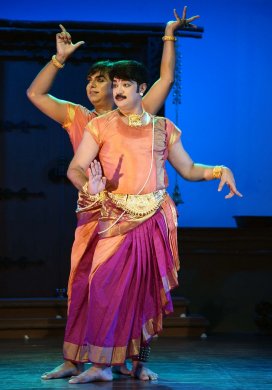 Shekar Rajendran & Dr. Sanjay Shantaram The evening began with two male Kuchipudi dancers Dr. Sanjay Shantaram and Shekar Rajendran, disciples of Guru Veena Murthy Vijay. Their Kuchipudi has old world charm, lilt, undulating movements, captivating style and they engaged attention from the word go. Their Ganesha Vandana in Tilang raga and adi tala was full of all these elements. Papanasam Sivan's prayer in Tamil translated in Kannada by Sanjay Shantaram, the speed with which they performed was praiseworthy as there was clarity in the movements. The iconic images of Ganesha as Vakratunda, eka danta, Gajamukha, Vighnahara came alive as one sang and other danced enhancing the visuals. Their duet in praise of dance of Shiva, Sandhya Tandavam, from the Sapta Tandavam, described lifting of the left foot to establish Dharma, and the right foot to crush the demon Muyalaka - symbol of ego, arrogance, adharma - danced with vigour. This particular work was originally choreographed by late C.R. Acharyalu and it had all the ritualistic, temple worship elements. When Lord Shiva danced, nattuvangam was done by Lord Brahma, Vishnu played mridangam, Gandharvas sang. The snakes adorning Lord Shiva and Ganga in Jata also danced. The dance included the charis and karanas mentioned in Natyashastra. The lord displayed the evils of kama, krodha, mada, moha, lobha and matsara. Both dancers have an excellent sense of rhythm and ability to project the emotions. They reminded me of the dance one used to watch in Kuchipudi village. 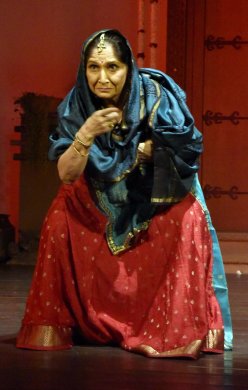 Uma Dogra From Mumbai, Kathak exponent Uma Dogra took to the stage mentioning that she did not want to present the chakkars and vigorous elements of Kathak dance. Uma performed abhinaya to an ashatpadi Sakhi he keshi mathana mudaram using Kathak vocabulary. It was a welcome approach extending boundaries of Kathak. Years ago in 1957, I had seen late Maya Rao, disciple of Guru Shambhu Maharaj, doing abhinaya to ashtapadi Lalita lavanga lata parishilana…. Rarely do Kathak dancers perform abhinaya to ashtapadis. Uma was moved seeing the ashtapadis by Guru Kelucharan Mohapatra in Odissi. Radha beckons her sakhi to confide in her, the first encounter she had with beloved Krishna. Using Kathak gatbhava, bindi ki gat, rukhsar ki gat, she wove magic displaying her lajja, coyness, at approach of Krishna, who with his melodious flute melted her heart, spoke sweet nothings in her ears and cleverly undid the lower garment for the union. Turning her back to the audience, Uma with her hands around her body created illusion of Krishna holding her and kissing her. All these gestures were performed delicately and with great restraint. Krishna, who had subjugated Kaliya, was the Lord of the universe. 'More handsome than Madana, Kamadeva, when I went for abhisara to meet him in the dark night, overcoming all obstacles,' Radha recalls. Uma expressed the emotions of shringara suggestively. The melodious singing of Manoj Desai and rhythm by Vinayak Netke highlighted the mood of the ashtapadi. Uma was again in her element in enacting her favourite piece for abhinaya on Manthara. With dialogues written by her husband, the renowned script writer Chitrarath and delivered by Uma herself as Kaikeyi and Manthara, she drew a portrait of Manthara, her devilish ambition and loyalty to Kaikeyi with whom as a maid she had come to Ayodhya, her desire to have Bharata as the king instead of Rama, brilliantly enacted by her. In a trice she would turn into royal queen Kaikeyi and again hunchbacked Manthara, wearing expressions of determination and cleverness, reminding Kaikeyi to ask the two boons Dasaratha had granted her and send Rama to forest and crown Bharata as king. Using Ramacharitmanas as a source, she unleashed the power of Manthara to which audience gave rounds of applause. The music was composed for the piece by Alap Desai. The finale by Uma and her prime disciple Sarita Kalele was a Tarana in Megh raga. Uma said that some items look nice on young dancers, whereas she was past that age, but dancing as a duet, both would reveal the beauty of Kathak. The interweaving of tatkar, taking chakkars and coming pat on sam, also executing gats, taking palta, with bindi ki gat and rukhsar ki gat, both performed with élan and perfection. Kathak is the only form in which a dancer has freedom to talk with the audience. Uma also mentioned that watching Kelucharan Mohapatra during the workshops he conducted at NCPA in Mumbai, she was inspired by the legendary guru to explore abhinaya as she did in Manthara. 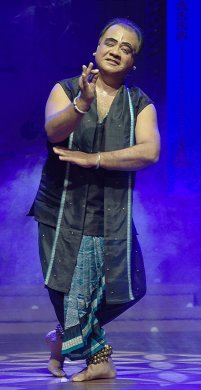 Ratikant Mohapatra Guru Kelucharan Mohapatra's worthy son Ratikant Mohapatra, with his solo act of Shabari, the devotee of Lord Rama waiting for his arrival, captivated the audience by his mature abhinaya, complete identification with the character, to the singing of chopais of Ramacharitamanas. As Tulasidas sings Shyam gaur dou sundar bhai, handsome, dark Rama and fair Lakshmana, two brothers, Shabari pari payi, Shabari fell at their feet. Waiting for Rama's arrival, she cleaned her humble cottage, spread the asan for Ram's sitting, collected the berries to offer him, and when Rama and Lakshmana arrived, she was overjoyed, shed tears of happiness, washed Rama's feet, took the water as charanamuruta - the nectar - and bowed to Rama. Shabari offered berries first tasting and then giving to Rama, which with great delight Rama ate. Shabari thinks how fortunate she is, a low caste woman, adham jati janami, as Rama accepted her offerings and released her from the bonds of this sansara. Ratikant's abhinaya was so graphic that it transcended his physical frame and one saw the tears dropping from his eyes, his boundless joy and one saw Shabari only. This is a blessing he has received from his legendary father, whose abhinaya transported audiences to another level of enjoyment. Ratikant is following his father's legacy which for present generation is a boon. It was an excellent performance. 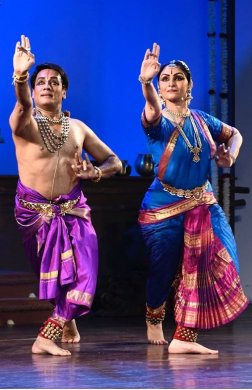 Satyanarayana Raju and Soundarya Igoor The concluding performance was by Bangaluru's stalwarts Satyanarayana Raju and Soundarya Igoor. They have earned a formidable reputation for their excellent dance and abhinaya. Trained by Guru Narmada, they have nurtured her training over the years lifting their performance to spiritual heights. They opened their performance with Pushpanjali, a composition of Reji George, set to raga Nagasvaravali and adi tala, choreographed by Savitri Jagannath Rao. It was followed by Muthuswami Diskhitar's Ardhanarishwara in ragamalika, adi tala, choreographed by Satyanarayana Raju and Soundarya. Their nritta had architectonical beauty, with their diagonal arms and sideway positions, exploring the space. What was interesting was the silence in-between the singing. The broad movements by Satya and Soundarya added charm to the number. At times they resorted to slow motion which gave relief from speed. The epithets like Nagendramani bhushanaya were shown with hastas suggesting serpents as ornaments, and Shiva with his vehicle Nandi; Soundarya sat on floor with Nandi hasta. They took various poses that suggested half of Shiva's body and the other half of Parvati's body. Satya stood behind Soundarya in a manner that half his body was seen with Soundarya's half body. They also moved sideways to show the ardha aspect. Brilliant choreography. Soundrya chose to present a Marathi bhavagita that spoke of Radha who had not got up when the entire Gokul had woken up. The song described the magic of Krishna's flute which spread all over Gokul in wee hours. However what Saundarya interpreted was the effect of melodious flute on Kubja who was cursed and her figure was turned crooked. She with one mind prayed for Krishna's touch that would remove her disfigurement. I was not able to understand this interpretation as the song spoke of Radha who did not wake up. It seems that since the song speaks of the magic of flute, Kubja listens to it and awaits Krishna whose touch restores her original form. Gokulnirgaman, Kirshna leaving Gokul and leaving his flute behind, which Radha picks up had poignant movements, as Satya impersonated Radha with intense feelings. The flute, Radha recalls, reminded of their secrets, loves, events like Krishna lifting mount Govardhana when Indra sends rains, touching peacock feather, how peacock and cows danced listening to the flute, their meetings on banks of river Yamuna, how Krishna subjugated Kaliya, and the various ways Radha and gopis addressed Krishna as Madhava, Yadava, Gopala, Muraliwala, Krishna. The anguish of Radha was palpable. Satya in the end picks up a real flute from the accompanying musicians and hugged it to his heart! He was in form enacting the agony of Radha when Krishna left Gokul. The piece de resistance was Tyagaraja's Endaro Mahanubhavulu, the evergreen composition set to Sri raga and choreographed by Satya and Soundarya. Replete with devotion for Lord Rama it had select but touching sancharis like Rama's feet touching Ahalya, Rama relishing Shabari's berries - Satya convincingly acting as Shabari - the duel between Rama and Ravana, in nutshell events of Rama lifting Shiva's bow, Sita garlanding Rama, Ravana's kidnapping Sita, final shooting of arrow and Ravana's death, devotees singing Samagana and so on. I would like to quote what Karthik Hebbar has mentioned in his Facebook posting about this presentation: 'The masterpiece was paintings in motion. The nritta was aesthetically rich, mature and full of poise. The aramandi, angashuddhi, and arudhis could put teenagers to shame. The padarthabhinaya was crystal clear and full of nuances. The sancharis were brisk, kept shining with their artistry. Their presentation was definitely the 'gem' amongst performances and was proof of their stature and popularity. It was a feast to say the least.' His words echo many of us who were moved to see this rare performance. Thanks to Adhyasha and Shishirchhanda Festival we saw such rich fare of performances, even though the two day time limit was constraining. The compering on first day was by Sneha Kapanna and on day two by Madhulika Srivatsa. For curating the festival with limited manpower, Sarita deserves congratulations. For next edition of Shishirchhanda, she will have to enroll more volunteers. I am sure she will get the support of well wishers for her festival.  Dr. Sunil Kothari is a dance historian, scholar, author and critic, Padma Shri awardee and fellow, Sangeet Natak Akademi. Dance Critics' Association, New York, has honoured him with Lifetime Achievement award. Post your comments Please provide your name and email id when you use the Anonymous profile in the blog to post a comment. All appropriate comments posted with name and email id in the blog will also be featured in the site. |